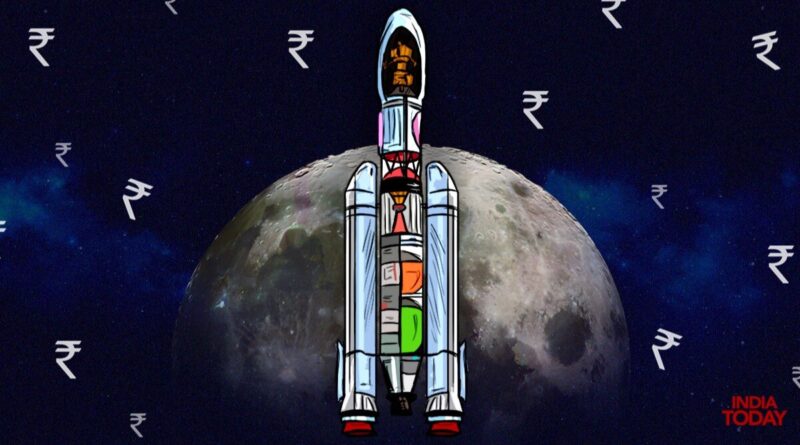Isro’s Chandrayaan-3 mission and its potential to boost Indian economy
By Koustav Das: The Indian Space Research Organisation (ISRO) is gearing up for the launch of its ambitious Chandrayaan-3 mission on July 14. This upcoming lunar exploration mission holds significant promise for the Indian economy.
As India gives its ambitious moon mission another shot, the spotlight is once again on its potential to propel the space sector and drive economic growth. However, before delving into the economic benefits, it is crucial to grasp the significance of missions like Chandrayaan-3.
Pawan Chandana, Co-Founder and CEO of Skyroot Aerospace, a leading domestic aerospace company credited with launching India’s first privately developed rocket, told India Today.in that Chandrayaan-III, once successful, could take India to the top league along with the US, Russia, and China.
“Chandrayaan-III is a major step in India joining the elite club as the fourth country to successfully accomplish a moon landing,” Chandana said.
India’s space tech rush
India’s latest space mission is a testament to the country’s remarkable progress in space exploration and technology. Six decades after its first rocket launch, India now has a surer footing in the field of space exploration and technology.
Also Read | Chandrayaan-3 launch: When will India’s lunar spacecraft land on the Moon?
Today, India’s private space-tech ecosystem is beaming with a vast horizon of opportunities, thanks to a new generation of entrepreneurs like Chandana. Just a couple of years ago, India’s space economy was valued at over $9.6 billion in 2020. By 2025, this could go up to $13 billion, according to EY India.
At present, the country has over 140 registered space-tech startups, including Skyroot, SatSure, Dhruva Space, and Bellatrix, who are working towards creating technologies that have real-world utilities – from satellite-based phone signals, broadband, OTT, and 5G to the operation of solar farms and much more.
Also Read | Chandrayaan-3 launch in July: Here’s all that India is sending to the Moon
Venture capitalists are increasingly seeing India’s space-tech sector as a lucrative opportunity, given the scale of the market and the sector’s historic achievements in 2022. The year was marked by many firsts, including a private rocket launch and multiple other satellite launches.
Greater private participation in India’s space industry with the approval of the Indian Space Policy 2023 is likely to provide a bigger boost to the Indian space-tech ecosystem in 2023. Initiatives like the Indian National Space Promotion and Authorization Centre (IN-SPACe) have already promoted private participation in space activities.
Chandrayaan-3’s success and its economic impact
As far as the Chandrayaan-3 mission is concerned, a successful landing will be a decisive moment for India. It will not only give the country an edge in the space exploration race but also contribute to the economy.
From employment generation to increased private investments and even technological advancements, there are several ways in which the Chandrayaan-3 mission can provide a boost to various aspects of the Indian economy.
In pics | Chandrayaan-3 mission rolls out for launch to the Moon
Investment boost
The successful launch of Chandrayaan-3 could bolster investor confidence and attract more private investment in space technology.
Pawan Chandana said if the Chandrayaan-3 mission concludes successfully, it will make India the fourth country to achieve the feat, adding that it will significantly boost investments.
“This will benefit the industry in a way that it promotes the cost-efficient and highly reliable space-grade hardware that the Indian space industry has supplied for this mission, increasing revenue flow and investments into the industry. It also validates our industry to become suppliers to lunar programs by other countries,” Chandana said.
Also Read | Chandrayaan-3 launch: Why landing on the Moon is a nightmare
And with the likes of Google already investing in India’s space-tech startups, it won’t come as a surprise if investments by foreign companies increase following the success of the Chandrayaan-3 mission.
“The moon is considered the gateway to the next phase of space exploration and the in-space economy. As investments in the space industries are soaring year by year, countries with this capability have more opportunities for global investments,” Chandana said.
Moreover, increased private sector involvement can lead to the emergence of new startups, businesses, and job opportunities, further driving economic growth and innovation.
Impact on space start-ups and jobs
The rapid growth in India’s space-tech ecosystem has created thousands of jobs over the past few years since the pandemic but has historically struggled due to a lack of focus on the space economy. But today, the sector has the potential to create lakhs of jobs, both blue-collar and white-collar.
“The space industry requires high-tech skills in science and engineering. This know-how is a strategic asset for the country. India’s investment in moon missions alone generated several hundreds of direct high-tech jobs and thousands of indirect jobs,” said Chandana.
“As this sets a path to many more missions to the moon, we can expect several thousand jobs to be generated by both the Indian government and private lunar programs,” he added.
In addition to jobs, the Chandrayaan-3 mission will also open up commercial opportunities for Indian companies and startups in the space sector. Chandana explained that the success of the mission will add to India’s goodwill in the space league and serve as a technology demonstrator for future moon missions.
“This can attract joint ventures into India and can help Indian companies and startups design and manufacture space systems and subsystems for the world,” he said.
Also Read | No agreement yet on manned mission with US, says Isro chief
Global positioning
Last but not least, the success of the mission would position India among the top four technologically-advanced space nations and pave the way for important international collaborations, similar to the recent Artemis Accord signing between ISRO and the American space agency NASA.
Chandana said, “This (Chandrayaan-3 mission) will boost more investments to take advantage of the cost efficiency and abundance of high-tech skill to build products and services in India for the world.”
The success of the ambitious lunar mission could also position India as a potential counterweight to China in the global space race.
Along with Russia, China offered low-cost options for launches. But with Russia reeling under economic pressure due to its conflict with Ukraine, India has a perfect opportunity to compete and strengthen its position.
All eyes will now be on the Chandrayaan-3 mission’s launch to the moon on July 14.




